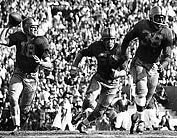LINKS
Golden Moments in Sports History Archive
LINKS
|
 Fritz Pollard |
Boston College, coached by Frank Leahy before he moved to Notre Dame, earned bids to the 1940 Cotton Bowl and 1941 Sugar Bowl. In both cases, the Jesuit school agreed not to play its black halfback, Lou Montgomery, who was left at home for the Cotton Bowl against Clemson and watched the Sugar Bowl against Tennessee from the press box.
Fast forward to the 1946 season. Penn State finished 9-0 and was invited to play in the Cotton Bowl against SMU. Problem: PSU's RB Wally Triplett was the first African-American ever to start for the Nittany Lions. The school had cancelled a road game against Miami rather than play it without Wally (who had mistakenly been recruited by the Hurricanes during his high school days). As a segregated school in segregated Dallas, SMU could have refused to play Penn State. However, school officials agreed to participate and worked with city government to arrange for the Lions to stay at an air base outside the city. No controversy surrounded the game itself, which ended 13-13.
 Bobby Grier (35) in Sugar Bowl |
|
What is interesting is that the Georgia Tech team and almost all the student body rejected Griffin's demands. The Yellow Jackets had played against black players before, including a game at Notre Dame two years earlier, but never in the South. Backed by his Board of Regents, the Tech president said his team would honor its contract.
The Pitt team stayed at Tulane since N.O. hotels were segregated. Grier could not attend some team events but found a warm welcome elsewhere.
The game was much more boring than the buildup. (I watched it on TV.) The only score came after a disputed interference call on the goal line against none other than Bobby Grier in the first quarter. Tech held on for a 7-0 victory. Grier reported good sportsmanship by the opponents. "They helped me up off the ground a couple of times when they tackled me."
There is no clear documentation on when the Orange Bowl was integrated. Prentice Gautt, the first black player for Oklahoma, was the MVP in 1959. He was also on the Sooner teams that played in Miami in 1956 and 1958.